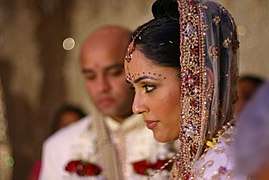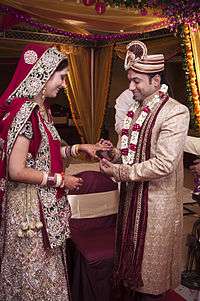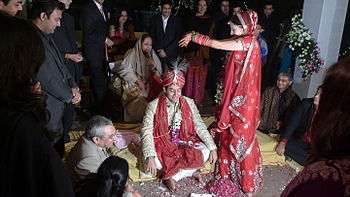Weddings in India
- Weddings in India
 A bride during a traditional Hindu wedding ceremony in Punjab, India.
A bride during a traditional Hindu wedding ceremony in Punjab, India.
 An Indian Hindu wedding ceremony in progress.
An Indian Hindu wedding ceremony in progress. An Indian bride.
An Indian bride.
Weddings in India vary regionally, the religion and per personal preferences of the bride and groom. They are festive occasions in India, and in most cases celebrated with extensive decorations, colors, music, dance, costumes and rituals that depend on the religion of the bride and the groom, as well as their preferences.[1] India celebrates about 10 million weddings per year,[2] of which about 80% are Hindu weddings.
While there are many festival-related rituals in Hinduism, vivaha (wedding) is the most extensive personal ritual an adult Hindu undertakes in his or her life.[3][4] Typical Hindu families spend significant effort and financial resources to prepare and celebrate weddings. The rituals and process of a Hindu wedding vary depending on region of India, local adaptations, resources of the family and preferences of the bride and the groom. Nevertheless, there are a few key rituals common in Hindu weddings – Kanyadaan, Panigrahana, and Saptapadi; these are respectively, gifting away of daughter by the father, voluntarily holding hand near the fire to signify impending union, and taking seven steps before fire with each step including a set of mutual vows. After the seventh step and vows of Saptapadi, the couple is legally husband and wife.[4][5][6] Jain and Buddhist weddings in India, share many themes, but are centered around their respective religious ideas and texts.[7][8]
Sikhs get married through a ceremony called Anand Karaj, a ritual started by the third leader of Sikhism, Guru Amar Das. The couple walk around the holy book, the Guru Granth Sahib four times. Indian Muslims celebrate a traditional Islamic wedding following customs similar to those practiced in the Middle East. The rituals include Nikah, payment of financial dower called Mahr by the groom to the bride, signing of marriage contract, and a reception.[9] Indian Christian weddings follow customs similar to those practiced in the Christian countries in the West in states like Goa but have more Indian customs in other states.
In the past, the age of marriage was young.[10] The average age of marriage for women in India has increased to 21 years, according to 2011 Census of India.[11] In 2009, about 7% of women got married before the age of 18.[12] Arranged marriages have long been the norm in Indian society. Even today, the majority of Indians have their marriages planned by their parents and other respected family members. Recent studies suggest that Indian culture is trending away from traditional arranged marriages.[13] Fewer marriages are purely arranged without consent and that the majority of surveyed Indian marriages are arranged with consent. The percentage of self-arranged marriages (called love marriages in India) have also increased, particularly in the urban parts of India.[14]
See also
References
- ↑ Sari nights and henna parties, Amy Yee, The Financial Times, May 17, 2008
- ↑ India's love affair with gold, CBS News, February 12, 2012
- ↑ Hindu Saṁskāras: Socio-religious Study of the Hindu Sacraments, Rajbali Pandey (1969), see Chapter VIII, ISBN 978-81-208-0396-1, pages 153–233
- 1 2 The Illustrated Encyclopedia of Hinduism: A-M, James G. Lochtefeld (2001), ISBN 978-0-8239-3179-8, Page 427
- ↑ History of Dharmasastra, Vaman Kane (1962)
- ↑ P.H. Prabhu (2011), Hindu Social Organization, ISBN 978-81-7154-206-2, see pages 164–165
- ↑ Natubhai Shah (1998). Jainism: the world of conquerors. Sussex Academic Press. pp. 203, 263. ISBN 978-1-898723-30-1.
- ↑ Axel Michaels (2015). Homo Ritualis: Hindu Ritual and Its Significance for Ritual Theory. Oxford University Press. pp. 102–104, 266–268. ISBN 978-0-19-026264-8.
- ↑ Three Days of a Traditional Indian Muslim Wedding, zawaj.com
- ↑ Heitzman, James. "India: A Country Study". US Library of Congress. Retrieved 26 December 2012.
- ↑ Women and men in India 2012 CSO/Census of India 2011, Government of India, pp xxi
- ↑ K. Sinha Nearly 50% fall in brides married below 18 The Times of India (February 10, 2012)
- ↑ Manjistha Banerji; Steven Martin; Sonalde Desai (2008). "Is Education Associated with a Transition towards Autonomy in Partner Choice? A Case Study of India" (PDF). University of Maryland & NCAER.
- ↑ David Pilling (June 6, 2014) Review – ‘India in Love’, by Ira Trivedi; ‘Leftover Women’, by Leta Hong The Financial Times
External links
| Wikimedia Commons has media related to Wedding ceremonies in India. |